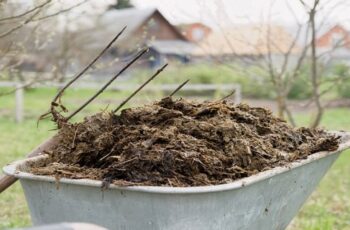Ad Blocker Detected
Our website is made possible by displaying online advertisements to our visitors. Please consider supporting us by disabling your ad blocker.
Now we’re going to build up our materials in layers, just like we were making a delicious baked pasta dish.
- Soak your high-carbon brown material in water
- On top of the newspaper layer, alternate the following –
- 10cm of the soaked “brown organic material” (e.g., autumn leaves or straw)
- 5cm of manure – e.g., horse, cow, sheep
- Water well after each layer is added
- Keep adding these layers until you get to your desired height. We recommend building up the garden at least 30-40cm.
- Make sure that the top layer is the brown organic material, which acts as a great mulch to suppress weeds, hold water and insulate the soil
- To plant seedlings, pull aside the mulch and add one or two handfuls of compost to the hole that you’ve created. Make a hole in the compost and plant the seedling into this compost.
NOTE: The no-dig garden will approximately halve in height in the first six months as it composts away. Therefore, if for example, you want a 30cm high veggie bed, build a 50-60cm no-dig garden.
During this time the layers that you put down will turn into fertile black compost. After these few months, any vegetables should grow very well in the no-dig garden. However, in those first 2-4 months (the first growing season of the bed), the following vegetables will not grow especially well in a no-dig garden, so don’t be disheartened:
- Root vegetables – e.g., carrots, onions, beetroot
- Beans or peas.
These veggies will grow well from the second season onwards.
To maintain the health of the no-dig garden area, VEG recommends adding homemade compost at least once a year (the start of spring), but preferably twice a year (the start of spring and the start of autumn).
Raising a ‘no dig’ garden has recently become all the rage because of its simplicity. What do you think? Could you become the next ‘no dig’ gardener?
[mashshare]

